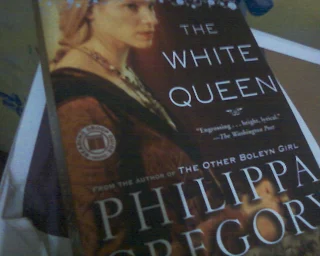This book centers on the colorful life of Elizabeth Woodville, wife of a cavalry officer who died during the battle of St. Albans at the height of War of the Roses fought by the Houses of Lancaster and York. He left behind two sons, Thomas and Richard who would suffer a terrible fate under the reign of King Richard III.
Elizabeth was a daughter of an English nobleman who sided with the Lancastrian group during War of the Roses, when the Lancastrian King, the mad Henry VI, was imprisoned and murdered and his wife, Queen Margaret, fled to France, The Woodvilles switched loyalty to Yorks to prevent imprisonment. The leader of the Yorks, 22-yeard-old Edward, immediately crowned as King Edward IV. Elizabeth was described in the book as extremely beautiful and attractive, having descended to one of the noted white goddesses of beauty, Melusina, no surprising, she would soon attract the attention of the young King, breaking the unwritten rule of royal traditions of marrying a foreign Princess to form a political alliance.
She eventually married the King secretly which shocked the Kingdom, Edward's courtiers, especially Richard Neville, the Earl of Warwick was infuriated with this breaking of tradition that soon he left the royal court and sided with the Lancasters. For many centuries, the life story of this English Queen Consort, had been the subject of intense scrutiny and research that many historians presented different theories on how she came into prominence at the expense of the Kingdom. Some portrayed her as heroine, others believed she was a villain and a traitor. This book however did not answer any of these doubts and me too find this book slightly disappointing, nevertheless it satisfies my curiosity who was really Elizabeth Woodville.
Elizabeth was a daughter of an English nobleman who sided with the Lancastrian group during War of the Roses, when the Lancastrian King, the mad Henry VI, was imprisoned and murdered and his wife, Queen Margaret, fled to France, The Woodvilles switched loyalty to Yorks to prevent imprisonment. The leader of the Yorks, 22-yeard-old Edward, immediately crowned as King Edward IV. Elizabeth was described in the book as extremely beautiful and attractive, having descended to one of the noted white goddesses of beauty, Melusina, no surprising, she would soon attract the attention of the young King, breaking the unwritten rule of royal traditions of marrying a foreign Princess to form a political alliance.
She eventually married the King secretly which shocked the Kingdom, Edward's courtiers, especially Richard Neville, the Earl of Warwick was infuriated with this breaking of tradition that soon he left the royal court and sided with the Lancasters. For many centuries, the life story of this English Queen Consort, had been the subject of intense scrutiny and research that many historians presented different theories on how she came into prominence at the expense of the Kingdom. Some portrayed her as heroine, others believed she was a villain and a traitor. This book however did not answer any of these doubts and me too find this book slightly disappointing, nevertheless it satisfies my curiosity who was really Elizabeth Woodville.
In medieval time when royalty strictly choose a Queen Consort who is virgin and unblemished, Elizabeth was far from that category. As a non-princess and a widow, she was hardly an appropriate choice to be the wife of a King, all the courtiers, relatives and family of Edward IV despised her. It was clear that soon the plot to eliminate her was inevitable, but the King was so besotted that he did everything he could to protect her.
The Queen, however, suffered a terrible fate after her husband’s death. The treachery of her brother-in-law, Richard, the Duke of Gloucester, made her life intolerable. Because her son, who ascended as King Edward V, was still a minor, the Kingdom was under the regency of the Duke of Gloucester, but his ruthless and selfish character made him turned the table against the Dowager Queen and her family. He ordered the execution of Elizabeth’s brother and sons and persuaded the parliament to declare her marriage to the deceased King null and void, making her children all illegitimate therefore not eligible to succeed. So he ascended the throne as King Richard III and had his nephews, Edward V and his brother, Prince Henry, the Duke of York, imprisoned in the gloomy Tower of London, they were the famous “Princes of the Tower”. The Princes simply “vanished” and presumed dead, Queen Elizabeth and her daughter, Princess Elizabeth, were held prisoners.
I am quite familiar with the history of the British monarchy and was very shocked when Gregory fictionalized the ending of this book. The finale revealed that Prince Henry escaped the cruelty of Richard III. When the King summoned the Prince to be brought to the Tower of London to accompany his brother, Edward V, Queen Elizabeth revealed she had switch him for a young boy and made Richard believed it was Henry, she then sent Henry to France to live secretly and was taken care of by the family she supported. When Richard died in the Battle of Bosworth and the Lancastrian leader became Henry VII, the first of the Tudor monarchs, she sent an aide to France to get back Prince Henry.
But in British history, Prince Henry actually accompanied his brother in the Tower of London and both were killed to eliminate them in the line of succession.
But in British history, Prince Henry actually accompanied his brother in the Tower of London and both were killed to eliminate them in the line of succession.
Anyway, this book is only a fiction.
So why the author called her “The White Queen?” It is due to her legendary beauty and of having a water goddess figure as ancestor.
So why the author called her “The White Queen?” It is due to her legendary beauty and of having a water goddess figure as ancestor.

No comments:
Post a Comment